cybersecurity third party risk management refer to the potential vulnerabilities and threats that arise when an organization shares access to its internal systems, data, or processes with external parties. These external entities, such as vendors, suppliers, contractors, or service providers, may not uphold the same security standards as the organization itself. To effectively mitigate and manage third-party cybersecurity risks, organizations must implement robust strategies and best practices. This article explores the various types of risks associated with third-party relationships and provides actionable insights into minimizing these risks.

What the meaning of Third-Party Cybersecurity Risks
cybersecurity third party risk management refer to the potential vulnerabilities and threats that arise when an organization shares access to its internal systems, data, or processes with external parties. These external entities, such as vendors, suppliers, contractors, or service providers, may not uphold the same security standards as the organization itself. As a result, they can inadvertently introduce vulnerabilities and weaknesses that malicious actors can exploit.
Types of cybersecurity third party risk management
There are several key categories of cybersecurity third party risk management that organizations should be aware of:
Cybersecurity Risk
Cybersecurity risks involve the potential exposure or loss resulting from cyber attacks, data breaches, or other security incidents. When organizations collaborate with third parties, they must ensure that these entities have robust security measures in place to protect sensitive data and systems.
Operational Risk
Operational risks arise when a third party disrupts the business operations of an organization. This can include delays, service interruptions, or failures to meet contractual obligations. Organizations should establish clear service level agreements (SLAs) with third parties and have contingency plans in place to mitigate operational disruptions.
Legal, Regulatory, and Compliance Risk
Third-party relationships can impact an organization’s compliance with local legislation, regulations, or agreements. For example, organizations operating in highly regulated industries such as finance and healthcare must ensure that their cybersecurity third party risk management vendors comply with industry-specific regulations such as GDPR or HIPAA.
Reputational Risk
Reputational risks arise from negative public opinion caused by the actions or security breaches of third parties. A data breach or other security incident involving a third party can tarnish an organization’s reputation and erode customer trust. Organizations must carefully vet their cybersecurity third party risk management partners to minimize the potential for reputational damage.
Strategic Risk
Strategic risks occur when an organization fails to meet its business objectives due to issues with cybersecurity third party risk management vendors. These risks can include delays in product development, poor quality control, or inadequate support, which can hinder an organization’s growth and competitiveness.
Mitigating Third-Party Cybersecurity Risks
To effectively mitigate third-party cybersecurity risks, organizations should implement risk management program that encompasses the following strategies:
Vendor Inventory Management
Maintaining an up-to-date and comprehensive inventory of all vendors is crucial for managing cybersecurity third party risk management risks. Organizations should identify and categorize their vendors based on the level of risk they pose. This inventory should include information such as vendor contact details, services provided, and any associated risks.
Vendor Assessment Process
Establishing a robust vendor assessment process allows organizations to evaluate third-party vendors’ security controls and practices. This process should include a standardized questionnaire that assesses areas such as cybersecurity measures, compliance, and data protection practices. Evaluating vendors based on their responses helps organizations identify potential risks and make informed decisions about their partnerships
Ongoing Monitoring and Auditing
Continuous monitoring of cybersecurity third party risk management vendors is essential to identify and address emerging risks in real-time. Organizations should establish protocols for monitoring vendors’ security posture, including regular vulnerability assessments and penetration testing. By proactively monitoring vendors, organizations can detect potential vulnerabilities and take swift action to mitigate risks.
Contractual Agreements and SLAs
Clear contractual agreements and SLAs help set expectations and establish accountability with cybersecurity third party risk management vendors. These agreements should outline security requirements, data protection measures, incident response procedures, and liability provisions. Regularly reviewing and updating contracts ensures that they remain aligned with evolving cybersecurity best practices and regulatory requirements.
Incident Response Planning
Organizations should have a well-defined incident response plan that includes provisions for cybersecurity third party risk management incidents. This plan should outline the roles and responsibilities of all parties involved, communication protocols, and steps to contain and mitigate the impact of a security incident. Regular testing and refinement of the incident response plan are critical to ensure its effectiveness.
Cyber Insurance
Cyber insurance can provide an additional layer of protection against third-party cybersecurity risks. Organizations should consider obtaining cyber insurance policies that cover potential financial losses resulting from third-party breaches or incidents. Working closely with insurance providers can help organizations tailor policies to their specific risk profiles and industry requirements.
Regular Communication and Collaboration
Maintaining open lines of communication and fostering collaboration with third-party vendors is essential for effective risk management. Organizations should establish regular meetings, performance reviews, and reporting mechanisms to address any concerns, exchange best practices, and ensure ongoing compliance with security requirements.
Educating Employees
Employees play a critical role in mitigating cybersecurity third party risk management. Organizations should provide comprehensive cybersecurity training to employees, emphasizing the importance of securely interacting with third parties and recognizing potential threats. Educating employees about common attack vectors, such as phishing emails or social engineering techniques, can help minimize the risk of third-party-related incidents.
The Best IT Service for Cybersecurity in a Meta Tech Company
When it comes to choosing the best IT service for cybersecurity in a meta tech company, there are several key factors to consider. First and foremost, the service should have a proven track record of successfully managing cybersecurity risks. This includes implementing robust security measures, conducting regular audits, and staying up-to-date with the latest industry standards and practices.
Secondly, the IT service should have a comprehensive understanding of the unique cybersecurity challenges faced by meta tech companies. This includes knowledge of the specific technologies and systems utilized within the industry, as well as the ability to effectively mitigate risks associated with third party interactions.
Lastly, the best cybersecurity service in a meta tech company should be proactive in their approach. This means actively identifying potential vulnerabilities, anticipating emerging threats, and implementing proactive measures to mitigate risks before they can be exploited.
Conclusion
Effectively managing third-party cybersecurity risks is a critical component of an organization’s overall cybersecurity strategy. By understanding the various types of risks associated with cybersecurity third party risk management relationships and implementing robust risk mitigation measures, organizations can safeguard their digital ecosystem and protect sensitive data from potential breaches. The key to successful third-party risk management lies in proactive monitoring, continuous assessment, and clear communication with vendors. With risk management program in place, organizations can confidently navigate the complex landscape of third-party relationships and minimize their exposure to cybersecurity threats.






![Rapid7 Vulnerability Management]](https://meta-techs.net/wp-content/uploads/2025/03/What-is-Rapid7-Vulnerability-Management-1.webp)
